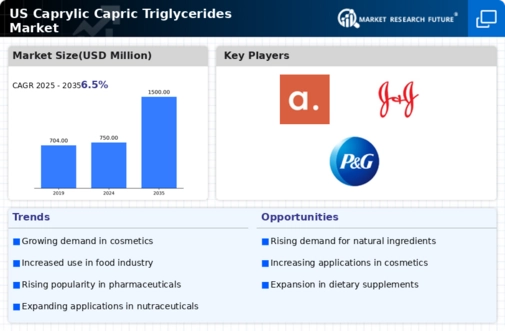Expansion in Nutraceutical Applications
The caprylic capric-triglycerides market is benefiting from the expansion of nutraceutical applications. As consumers seek natural and effective solutions for health and wellness, the incorporation of MCTs into dietary supplements is becoming more prevalent. Nutraceuticals, which combine nutrition and pharmaceuticals, are increasingly utilizing caprylic capric-triglycerides for their potential to enhance absorption and bioavailability of active ingredients. This trend is supported by a growing body of research indicating the efficacy of MCTs in promoting gut health and supporting immune function. The market for nutraceuticals is projected to grow at a CAGR of 7% through 2027, further bolstering the demand for caprylic capric-triglycerides in this sector.
Growing Demand in the Cosmetic Industry
The caprylic capric-triglycerides market is experiencing a notable increase in demand from the cosmetic industry. As consumers become more conscious of the ingredients in their personal care products, there is a growing preference for natural and non-toxic formulations. Caprylic capric-triglycerides are valued for their emollient properties and ability to enhance skin absorption, making them a popular choice in skincare and haircare products. The cosmetic market is projected to grow at a CAGR of 5% through 2028, which is likely to further drive the demand for caprylic capric-triglycerides. This trend indicates a shift towards cleaner beauty products, positioning caprylic capric-triglycerides as a key ingredient in the evolving landscape of cosmetics.
Increasing Awareness of Health Benefits
The caprylic capric-triglycerides market is experiencing growth due to rising awareness regarding the health benefits associated with medium-chain triglycerides (MCTs). Consumers are increasingly recognizing the potential advantages of MCTs, such as improved energy levels and enhanced cognitive function. This trend is particularly evident in dietary supplements and functional foods, where MCTs are often marketed for their ability to support weight management and metabolic health. As a result, the demand for caprylic capric-triglycerides is likely to increase, with the market projected to reach approximately $200 million by 2026. This heightened awareness is driving manufacturers to innovate and expand their product lines, thereby contributing to the overall growth of the caprylic capric-triglycerides market.
Technological Advancements in Production
Technological advancements in the production of caprylic capric-triglycerides are playing a crucial role in shaping the market landscape. Innovations in extraction and refining processes are enhancing the efficiency and quality of MCT production. These advancements not only reduce production costs but also improve the purity and functionality of the final product. As manufacturers adopt more sophisticated technologies, the caprylic capric-triglycerides market is likely to benefit from increased supply and improved product offerings. This trend is expected to attract new players into the market, fostering competition and driving further innovation in product development.
Rising Popularity of Plant-Based Products
The caprylic capric-triglycerides market is witnessing a surge in demand due to the rising popularity of plant-based products. As consumers increasingly adopt vegetarian and vegan lifestyles, there is a growing need for plant-derived sources of MCTs. Caprylic capric-triglycerides, often derived from coconut oil, align well with this trend, as they are perceived as a healthier alternative to traditional fats. This shift towards plant-based diets is influencing food manufacturers to incorporate caprylic capric-triglycerides into their formulations, particularly in snacks, beverages, and dairy alternatives. The plant-based food market is expected to reach $74 billion by 2027, which could significantly impact the caprylic capric-triglycerides market.














Leave a Comment